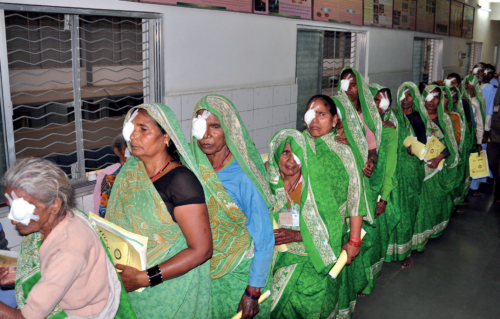Cataract is one of the major eye health disorders in the World leading to blindness and India is no exception to it. According to NPCB, Cataract alone is responsible for 62.6% of blindness among the Indian population. Cataract comes under avoidable blindness, which can be successfully treated with a surgery. The lack of basic eye care facilities, knowledge and less number of eyecare professionals like optometrists and ophthalmologists working in Indian rural villages is major cause leading to an increase in the prevalence of blindness. Cataract screening in rural villages can help to diagnose cataract at an early stage and prevent blindness among the rural population.
What is Cataract?
A cataract is a normal ageing process of the human lens which leads to its opacification and henceforth leads to a decrease in vision. The human lens is one of the most important parts of the eye, which is located behind the iris. The lens is mainly made of proteins and water, biochemical changes in the lens lead to the clouding of the lens. Cataracts can also be caused due to systemic diseases like diabetes or due to genetics. Due to the clouding of the lens, the light incident upon the eye scatters beyond the lens leading to vision-related problems and also discomfort.
Why cataract is responsible for 62.6% of blindness alone?
Due to a lack of knowledge of eye care facilities, less number of eye care professionals in India, and less number of ophthalmologists and optometrists working in rural areas.
Ways to overcome Cataract in India.
There are various ways which can overcome the problem of cataract. Some of them include eye camps, door-to-door surveys and outreach programmes with the help of local organizations. Various government and private organizations are working to overcome the blindness problem in India. Due to the larger population of India, govt efforts alone can not along deal with this vast problem. So it should be a combined role of local physicians, Primary health care nurses and Asha workers who can help identify one with reduced vision and can refer them to an eye care professional for further care.
- An eye camp at public health care center’s or in schools conducted by a mobile team of eyecare professionals has come up to be an effective way for screening cataracts. The eye examination is quick and painless; the results are also available soon. One detected with cataract can be further examined with a dilated eye examination and referred to an eye clinic or hospital for surgery.
- Door-to-door screening is another method for screening cataract, where Asha care workers or Primary health care nurses after proper training on how to record vision, which can be delivered to them by organizing one or two-day workshops by an optometrist. Primary health care nurses or Asha care workers can visit households and conduct basic eye exams on individuals. It is helpful for people who cannot come to centers due to their disabilities or other health conditions. It is also useful for people who are hesitant or fear health checkups due to cultural or social reasons. A vision chart with a pen torch is sufficient for the detection of cataracts by the Asha care worker. On diagnosing poor vision or cataract one can further refer them to the clinic or a higher district hospital for further assessment and treatment.
- Outreach programs work with the local community organization where the announcements are made one day before the health camps. Community leaders set up the camp at places where it is easy for villagers to congregate like temples or community centers. A team of optometrists and ophthalmologists can work together to screen cataracts. Cataract screening includes a comprehensive eye examination starting with visual acuity testing followed by dilated eye examination to check the pupil size and retina. Later, Diabetes and Hypertension levels are checked as high sugar levels or BP levels can cause complications during cataract surgery.
Role of an optometrist in cataract screening?
Optometrists are health care professionals, which provide primary vision care which includes vision check-ups, correction of refractive errors, diagnosis, treatment and management of various eye health diseases. Optometrists play an important role to reduce avoidable blindness due to cataract, by reducing the workload of ophthalmologists by screening people with cataract, educating the patient on the importance of cataract surgery, performing the pre-op examination, giving post-op care, regular follow up, referral to an ophthalmologist and conducting these camps
Conclusion:
Cataract screening is one of the most important eye health screenings which is required to be done in every village, to reduce the prevalence of blindness. A combined effort of local physicians, primary health care nurses, and Asha care workers along with eyecare professionals is needed to overcome this problem. Optometrists here play an important role in vision screening, diagnosing and educating them about cataract, training primary health care nurses and Asha care workers, annual eye examinations and various eye-related disorders.
References:
- Acosta R, Hoffmeister L, Román R, Comas M, Castilla M, Castells X. Systematic review of population-based studies of the prevalence of cataracts. Arch Soc Esp Oftalmol 2006;81:509-16
- Murthy GV, Gupta SK, Bachani D, Jose R, John N. Current estimates of blindness in India. Br J Ophthalmol 2005;89:257-60.
- Vaidyanathan K, Limburg H, Foster A, Pandey RM. Changing trends in barriers to cataract surgery in India. Bull World Health Organ 1999;77:104-9.

Intern Optometrist (Nethradhama Eye Hospital)

